What Do Crayfish Eat? Full Food & Diet List
Crayfish (aka crawfish or crawdads) are fascinating little creatures that eat many different foods. Their diet is broad and adaptable to nearly every aquatic environment you can imagine.
But exactly what do crayfish eat?
This guide will teach you all about the crayfish diet to help you gain a better understanding of these critters, and provide them with better care if you’re thinking about getting one.
What Do Crayfish Eat In Captivity?
Crayfish are opportunistic little creatures with a healthy appetite for just about anything!
Unlike some fish and even shrimp (although the latter is less common), crayfish are the opposite of picky. They’ll snack on whatever they can find!
Benefits They Bring To Your Tank
Because crayfish can eat so many different foods, there are a number of benefits that these little creatures can bring to your tank.
For starters, crayfish will also eat some of the things you don’t want in your aquarium.
They will readily consume many types of aquarium algae as well as bacteria. The decapods will eat away at algae that develop on the glass, decor, and any other surface in the aquarium.
Many of the 600-plus species of crayfish will also filter feed. They will filter the water and consume bacteria that would otherwise ruin the tank.
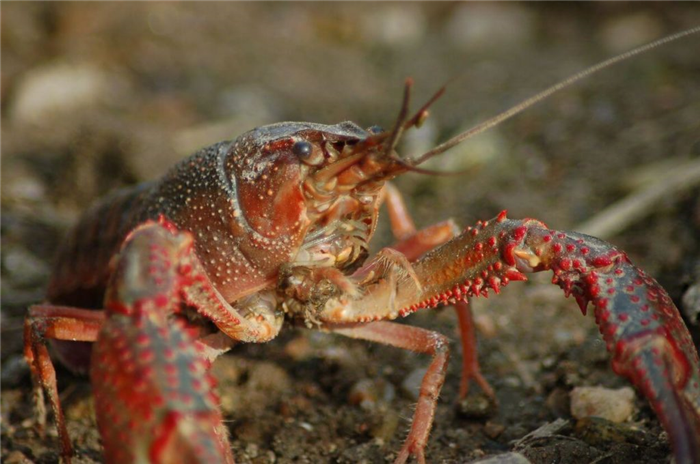
Their penchant for eating undesirables can do a lot to keep your aquarium clean and in good condition. They’re not going to replace your filtration system or regular maintenance duties, but you may notice your tank looking a little purer with crayfish in it!
In addition to eating things around the aquarium, crayfish will accept a wide variety of planned foods. As we mentioned earlier, they are not picky and will not stick their noses up at anything you provide.
You can give them dried food if you want. Due to their weak swimming abilities, sinking pellets are the preferred option. You might also see your crayfish eating any leftover fish flakes that sink to the bottom of the tank. This is a big plus, as leftover food is notorious for souring water conditions!
Additionally, crayfish will eat vegetables and protein-based snacks. Many aquarists like to provide small minnow fish or fry to give their crustacean something to hunt. Others will stick to commercial foods or prepared veggies.
Author Note: Whatever you decide to feed them, variety is key! Crayfish don’t get bored, per se. However, a bit of variety can ensure that they’re getting plenty of essential vitamins and minerals (as well as a little extra enrichment). In turn, their coloration and overall health can improve.
What To Watch Out For
So now you know what crayfish will eat when kept in an aquarium, and why that might be helpful.
However, there are some things you’ll need to consider before getting one. Interestingly enough, their ferocious appetite can quickly cause problems in a tank if you’re not prepared.
These decapods are fully capable of eating small, slow-moving fish. That means they can become a bit problematic if you stock your tank with daring fish that like to swim close to the crayfish. Those fish that can’t quickly dart out of the crustacean’s grasp will become food.
These creatures might even attempt to grab larger fish if they venture too close. However, they don’t do much damage to big fish. It’s the little ones you have to worry about!
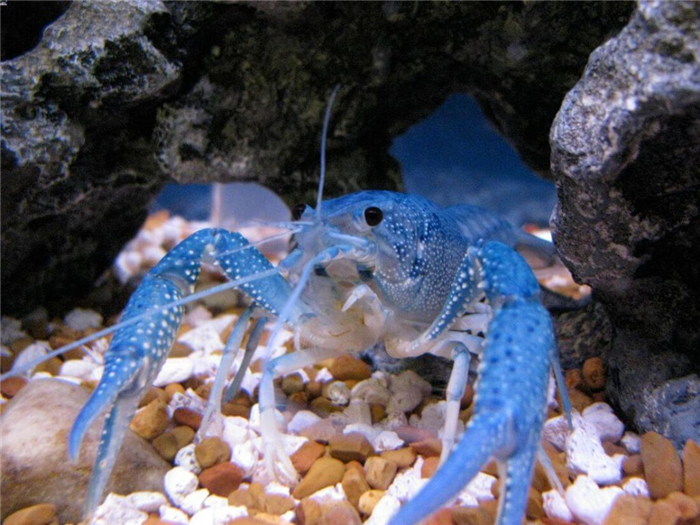
On the bright side, crayfish aren’t particularly strong swimmers, so it’s easy to introduce them to community tanks with a bit of careful planning.
Author Note: That said, don’t be surprised if you find your crayfish snacking on a fish carcass. When these inverts see an opportunity to eat, they’ll seize it. Dead or diseased fish are not off the table.
Another potential issue with crayfish? Plants!
Crayfish love snacking on plants. Lush aquariums filled with greenery are great for most freshwater fish and invertebrates. But with the crayfish, you have to plan for some potential destruction.
More delicate vegetation will be no match for your crayfish. They will use their larger front claws as the first two pairs of walking legs to shred fine plants to bits!
Hardy and fast-growing plant species are tough enough to survive crayfish snacking. Some good examples include hornwort and Java fern, but anything else will get destroyed slowly as the crayfish feast. If you’re caring for a large colony of crayfish, those plants will be gone before you know it!
What Do Crayfish Eat In The Wild?
Crayfish come from pretty filthy environments. Typically, they inhabit streams and rivers. But unlike most fish, they’re not able to get up to the top of the water column. Instead, they stick to the muddy riverbed.
While these are not exactly prime living conditions for many aquatic creatures, it’s a great environment for crayfish. You see, their diet in the wild consists of primarily decaying matter. It’s the easiest food that they can source.
Fast currents that sweep dead plants and animals downstream. Using their claws, they grab onto anything that manages to flow by. This could be decomposing aquatic and land-based animals or decaying plants. By the time it reaches the crayfish, it’s usually soft and easy to tear apart.
Because of this, crayfish play an important role in its natural ecosystem. They’re part of the circle of life!
When they’re not consuming dead things, they will also scavenge for other items around their natural habitat. Rivers and streams are teeming with life. They’ll eat algae they find on twigs and rocks, plankton that’s floating around the water, and small fish they can quickly grab onto.
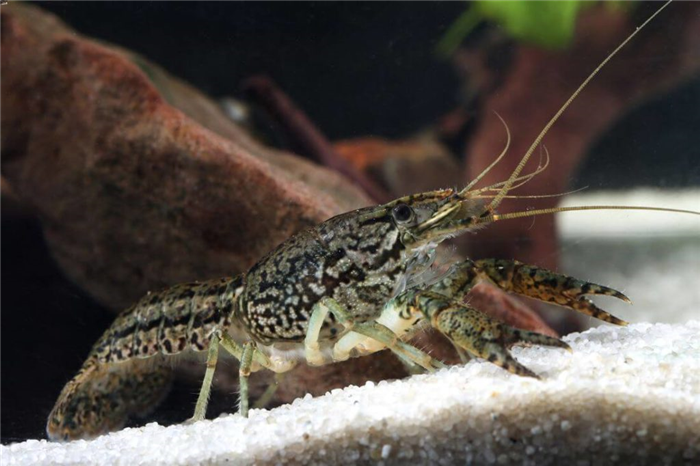
Crayfish aren’t strong swimmers. With a strong current working against them, the decapods are limited to whatever sinks to the bottom of the water column.
Luckily, there are plenty of things that end up there! Several creatures live down there along with the crayfish, too.
Many will also seek out worms, bugs, and tiny shrimp. Typically, crayfish have an abundance of food items to eat. But in particular dire times, these inverts may also cannibalize their own!
That behavior can occur in captivity, too (as mentioned in the section above). This means you need to make sure that your crayfish are always well-fed.
The Ideal Diet For Young Crayfish
You shouldn’t have too many issues finding suitable food options for your pet crayfish. But before you start planning their diet, you need to make sure they have a healthy environment where they can thrive.
Crayfish aren’t super demanding when it comes to decor or water conditions. However, they can’t be dramatically different than what they’re used to. Otherwise, you may see signs of stress.
These creatures can experience stress and anxiety just like humans. When they’re dropped into a strange new environment, many will have a hard time adapting. As a result, they avoid food! It’s very out of character, but it’s also more common than you would think.
Do your best to recreate a comfortable environment. Provide a nice layer of sand substrate that they can burrow in. Also, make sure that there are plenty of plants, rocks, and twigs. Crayfish need places to hide whenever they start getting anxious.
They’re fond of crevices and caves, so add those items to your aquarium to make things easier on your crayfish. Don’t forget about creating a small current as well.
Once you get the right living conditions, you can start experimenting with different foods.
Author Note: Remember that variety is important here. You’ll be hard-pressed to find a food that your crayfish doesn’t like, but don’t dwell too long on one food item. Mix things up for better results!
If you want to go the commercial route, you can use dry pellets. Shrimp pellets are a favorite among aquarists. They’re balanced, rich in vitamins, and sink down to the bottom of the aquarium for easy access!
You can also try algae wafers or dense protein-based snacks, such as frozen bloodworm blocks.
Speaking of protein, you have a lot of options here! Anything that you use on your fish is fine for your crayfish. Things like dried krill, mosquito larvae, and worms do well.
Many owners will also use their crayfish as decomposition machines. You can provide them with dead fish or shrimp from other tanks in your collection.
Avoid providing any diseased fish or those that died from parasitic infections. The last thing you want to do is spread the disease to your crayfish tank.
To give your crayfish a boost of vitamins, you can also give them some plant-based snacks. They will accept most vegetables. However, they are particularly fond of mashed peas, romaine lettuce, and small pieces of fruit.
Author Note: Remember how we said that their primary food source in the wild was decaying vegetation? Well, you can use that to your advantage in captivity, too. Give them any fresh vegetables that are starting to go bad, and these critters will get rid of them for you!
As you can see, there’s no shortage of things you can feed to your crayfish. Mix things up and provide tons of variety. Your crayfish will appreciate it!
Here’s a small list of food items you can add to your crayfish’s diet:
- Algae wafers
- Sinking pellets
- Shrimp food
- Standard fish food
- Mashed peas
- Frozen foods
- Brine shrimp
- Insects
- Live fry or feeder fish
- Dry krill
- Lettuce
- Small bits of fruit
- Blanched carrots
How Often Should You Feed Your Crayfish?
You don’t have to feed your crayfish massive amounts of food. They’ll eat in the tank throughout the day, so small meals are best.
As a good rule of thumb, provide pieces of food that are about three-quarters of an inch wide. Whether you’re providing pellets or cutting up small pieces of meat, that’s a good size for crayfish.
For newly born crayfish larvae, go a bit smaller. Provide food that’s about half an inch wide during their first couple of weeks of life. They grow up quickly, so it won’t take long for young crayfish to eat the larger chunks.
Juveniles and young crayfish can eat once a day. As they approach maturity, scale back to feeding them every other day.
Author Note: Don’t be alarmed if you see food sink to the bottom untouched. Crayfish are more active at night, so they often save substantial food for when they have more energy. Chances are, it’ll be gone by morning!
If they continue to ignore it, check water parameters to make sure that conditions are just right.
Aim to feed your crayfish the same amount of food, at the same time each day. These creatures are quite cunning and will pick up the routine. Once feeding time rolls around, they will start to come out of their hiding spots as they await your arrival!
Closing Thoughts
If you’re someone who has always wanted to know what crayfish eat, we hope this extensive guide has answered your questions. In short, these creatures have quite a large diet and can eat pretty much any food they find.
Let us know if there are any foods we didn’t cover on this list that you’re considering feeding to your crayfish. It doesn’t hurt to double check if you’re unsure!
Alison Yang
Alison has been interested in fish and aquariums for over five years. When she’s not writing about fish you can find her hiking, swimming, and doing yoga.
What Do Crayfish Eat?
To many people around the world, crayfish (also called crawfish or crawdad) is food. It is Louisiana‘s official state crustacean. But what does the food eat? Crayfish are freshwater crustaceans that look like small lobsters and even taste like lobster but are small like shrimp, with fattier tail meat than shrimp, and with fat stored in the head. And unlike the treatment of lobsters as a delicacy, crayfish are often used in home cooking. Let’s explore together what these so-called freshwater lobsters, rock lobsters, or mountain lobsters eat.
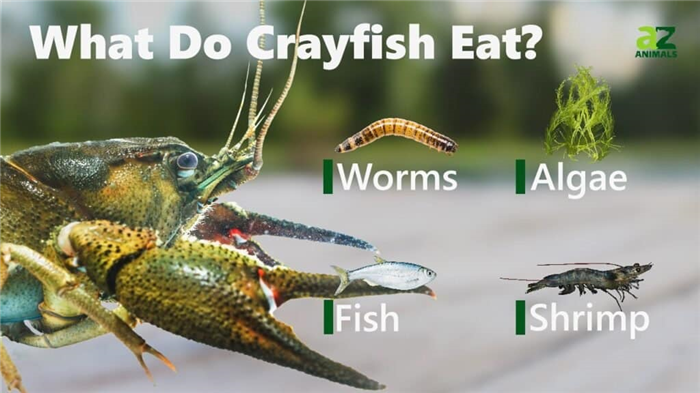
The crawdad or crawfish diet is omnivorous, that is, they eat both plant and animal matter.
The crawdad or crawfish diet is omnivorous, that is, they eat both plant and animal matter. Their habitat in the wild is flowing streams such as in a river or brook, but sometimes also in a pond, swamp, or ditch. Flowing rather than stagnant water allows them to reach their food easily. What they eat is anything that can float by them or sink to the bottom. That includes decaying vegetation and aquatic creatures such as rotten leaves, dead fish, algae, plankton, and twigs. But they can also be hunters and eat small worms, snails, eggs, larvae, insects, shrimps, fish, tadpoles, baby turtles, frogs, and even their own baby crayfish. Baby crayfish eat mostly algae. The crayfish diet in the wild is similar to that in a pond, but people who farm crayfish in ponds also feed them prepared vegetables and commercial food.
A Complete List of Foods Crayfish Eat
In the wild:
- Decaying vegetation, such as leaves or twins
- Dead fish
- Plankton and algae
- small worms, snails, eggs, larvae, insects, shrimps, fish, tadpoles, baby turtles, frogs
- Baby crayfish
In a pond:
- Decaying vegetation
- Dead fish
- Small aquatic creatures, invertebrates, eggs, larvae, and babies
- Baby crayfish
- Commercial pellets and algae
- Prepared vegetables
Baby crayfish:
The Crayfish Digestive System
The crawfish or crawdad is a decomposer as well as a detritivore, but it’s also a filter-feeder than takes in what’s suspended in water while already whole or in pieces. It must therefore have a unique digestive system that allows them to break down what they eat. The first organ is a two-part stomach. The cardiac stomach stores food and mechanically breaks it down with teeth, while the pyloric stomach chemically breaks it down, similar to the stomachs of vertebrates such as humans. There’s also a digestive gland, similar to a liver, and the intestine, which absorbs nutrients and excretes waste from the anus.
Foods That Are Bad or Toxic for Crayfish
Crayfish and other shellfish absorb toxins from the water. Some phytoplankton species also have toxins which can accumulate in shellfish and other creatures that eat them, but they accumulate at higher levels in larger creatures at the top of the food chain.
Crayfish, crawfish, or crawdads are a staple shellfish around the world and are the focus of certain spicy country cuisines, where they taste similar to and cook the same as lobster. These freshwater crustaceans lack a seawater flavor, unlike their saltwater counterparts, but they are likewise omnivorous. They are so savory and delicious because they eat a protein-rich diet.
Share this post on:
AZ Animals Staff
AZ Animals is a growing team of animals experts, researchers, farmers, conservationists, writers, editors, and — of course — pet owners who have come together to help you better understand the animal kingdom and how we interact.
What Do Crayfish Eat in the Wild and as Pets?
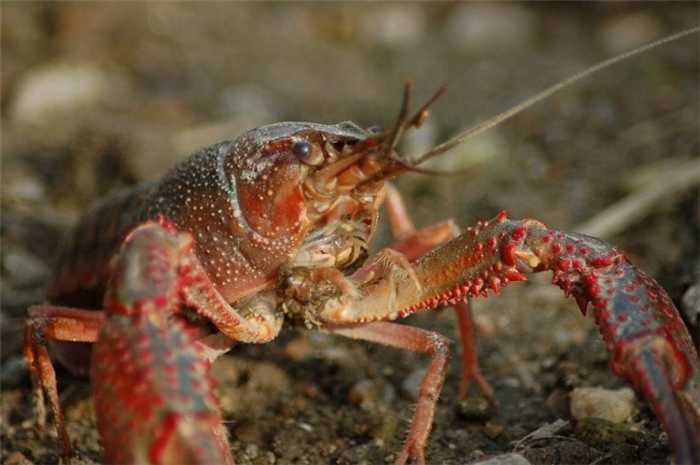
Crayfish are small crustaceans that look like mini lobsters. They live in fresh water and can be found living in streams, ponds, and marshes. They are great burrowers, which is why they prefer waters that are not brackish. Crayfish are considered delicious food by people throughout the world. However, they are also thought of as beloved pets by many households.
Also called crawfish and crawdads in some areas of the United States, this crustacean is an omnivore and maintains a varied diet of both meat and plant food. Crayfish have slightly different diets in the wild than they do in captivity. Here is everything you need to know about what crayfish eat both in the wild and as pets.
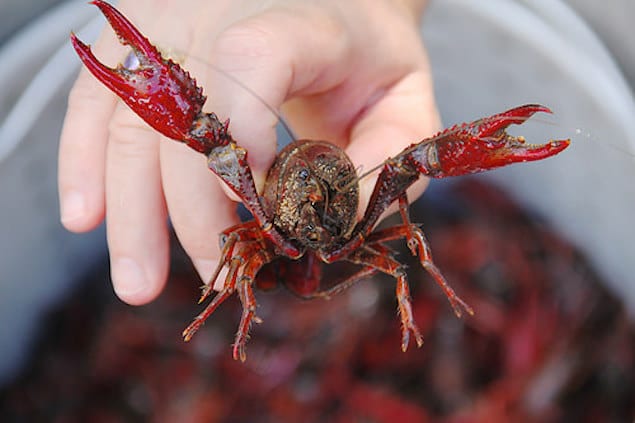
What Crayfish Eat in the Wild
In the wild, crayfish eat pretty much whatever they come across. Crayfish eat live and dead animals including fish and shrimp, plankton, algae, and even worms and insects. Crayfish also eat plant matter that gets into their water source and decomposes, such as grass, weeds, and tree leaves. The bottom line is that they are not picky when it comes to satisfying their hunger for nutrients.
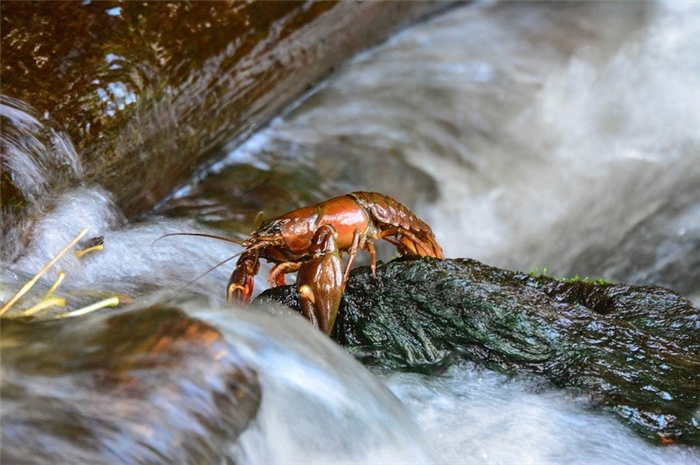
Image Credit: Gingerbreadmedia, Pixabay
What do Crayfish Eat as Pets
Crayfish can eat just about anything, so it is easy to feed them as pets. There is no need to go fishing or to scour ponds for decomposing plant matter to feed a pet crayfish. Commercial sinkable pellets are available that include things such as kelp, algae, and fish like salmon that can be used as the main part of a crayfish’s diet. Frozen peas, carrots chunks, zucchini slices, broccoli stems, and plants like java moss can also be added.
These crustaceans will try to eat any fish that you put in the tank with it, so live fish feeding is a possibility for pet owners who are serious about natural feeding methods. However, crayfish do not need much protein, so a diet free of fish is suitable for them if they are eating commercial pellets as their main source of nutrients.
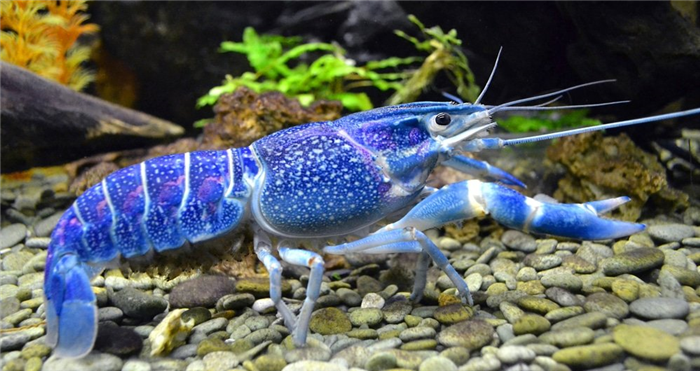
Feeding Crayfish at Different Stages of Life
Crayfish of all ages typically hide under rocks and in caves during daylight hours and come out at night to feed, so owners should provide them with food before their own bedtime. Younger crayfish tend to feed more aggressively than their fully grown counterparts, preferring protein-rich options over plant-based foods. As they get older, they start taking more of an interest in plant foods and eventually focus on the plants while eating little protein via animal sources.
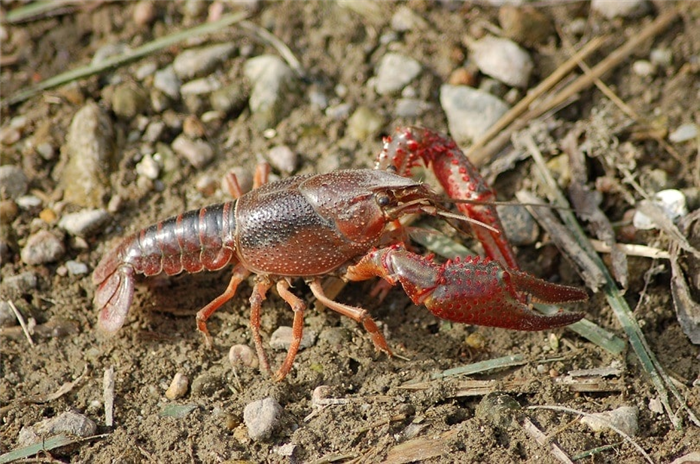
Image Credit: BARBARA80, Pixabay
Therefore, a young crayfish needs to be fed more pellets and fewer vegetables than adult crayfish. As their feeding intensity changes, so can their ratio of pellets and protein to whole plant foods. The types of vegetables they are fed should be varied to ensure that a pet crayfish gets all the vitamins, minerals, and antioxidants they need.
Tips for Properly Feeding Crayfish
Crayfish have sharp claws that can injure a human’s skin when pinched. Therefore, smaller pieces of food should be dropped into the freshwater tank from above to ensure that fingers do not come into contact with the crustacean’s claws. Longer foods, like carrot sticks and green beans, can be fed directly to crayfish, which tends to be a fun activity for kids. Any food that is leftover the next day should be taken out of the tank before a new meal is offered; otherwise, the tank will get dirty quickly and make the atmosphere unsanitary and unsafe for a healthy crayfish to live in.
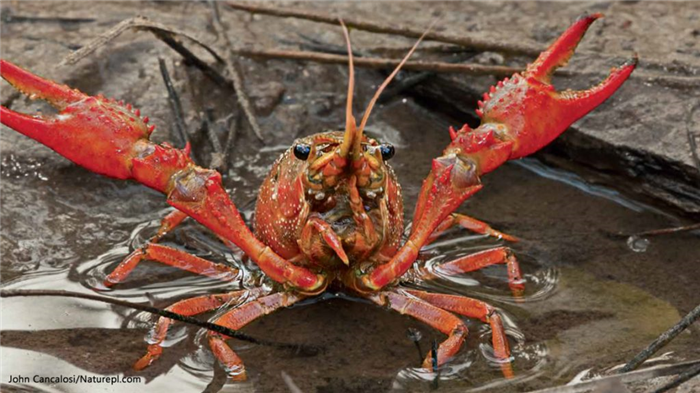
Our Final Thoughts
These crustaceans are surprisingly easy to feed using vegetable scraps from the kitchen. A crayfish can help lower a family’s carbon footprint by using up the leftovers so they do not end up in the garbage. How confident do you feel about feeding a pet crayfish so it stays happy and healthy throughout its lifetime? Tell us about your thoughts by leaving us a message in the comments section.

Featured Image Credit: BARBARA80, Pixabay
Lead Pet Expert & Pet-ditor in Chief
Nicole is the proud mom of 3 rescue fur babies, Baby, a Burmese cat; Rosa, a New Zealand Huntaway; and Mac, a Lab/Mastiff. A Canadian expat, Nicole now lives on a lush forest property with her Kiwi husband and new baby daughter in New Zealand. She has a strong love for all animals of all shapes and sizes (and particularly loves a good interspecies friendship) and wants to share her animal knowledge and other experts’ know ledge with pet lovers across the globe. . Read more
14 Rabbit Myths And Misconceptions You Need To Stop Believing Now!
Do Ferrets Need Vaccination Shots? Which Ones?
Cute Frogs: 9 Pictures That Will Make You Happy
How Many Babies Do Hamsters Have In A Litter? Breeding & Reproduction Guide
21 Things Crayfish Like to Eat Most (Diet, Care & Feeding Tips)
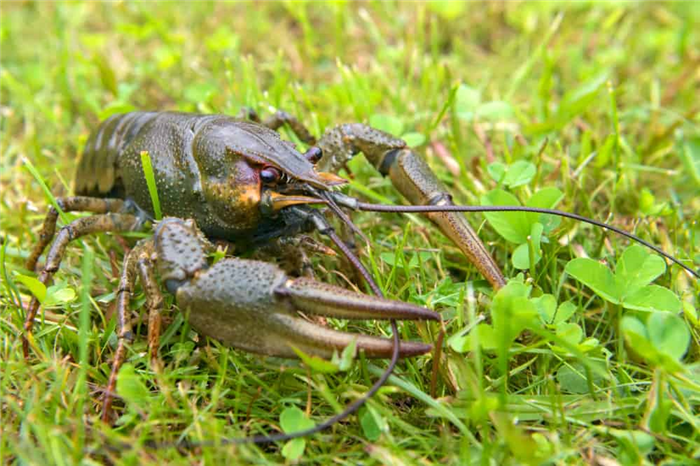
Crayfish are aquatic animals that look like lobsters but are smaller. Most people are accustomed to seeing them on their plates or restaurant menus. Have you ever wondered what lies on the crayfish menu?
What do crayfish eat? Read on to quench your curiosity.
Table of Contents
Crayfish Habits And Biology
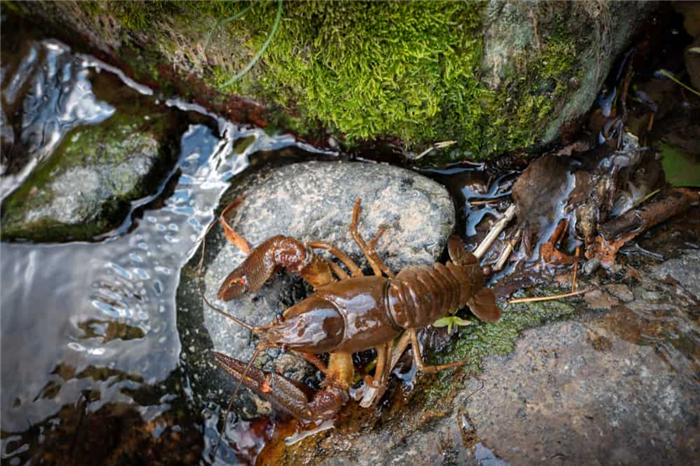
Crayfish, also known as mudbugs, freshwater lobsters, yabbies, crawdaddies, crawfish, among other names, are freshwater crustaceans (e.g.crabs, krills, shrimp) that are similar to lobsters.
The head of the crayfish has a pointed snout and compound eyes for overall vision. A thin but tough exoskeleton covers their bodies.
Adult crayfish can range anywhere from 2.5 centimeters to 7.5 centimeters in length, depending on the species. The largest crayfish species is the Astacopsis gouldi. This crayfish may reach lengths of up to 40 centimeters and weigh 3.5 kilograms.
They have 5 pairs of legs, of which the foremost pair have powerful pincers (chelae). The other pairs of legs are smaller and primarily used for swimming and circulating air for breathing.
They can be found in freshwater streams, whereas others prosper in paddy fields(flooded areas used for growing semiaquatic crops like rice), ditches, and swamps.
Crayfish breathe through their gills. They typically can’t tolerate polluted water. However, some species, such as the Plocambarus clarkii, have adapted to living in polluted waters.
There are over 500 species of crayfish worldwide, most of which live in freshwater bodies of North America. A few species dwell in saltwater, otherwise known as brackish water.
You’ll find them in streams and lakes where they hide under rocks. They are nocturnal and therefore are primarily active at night.
Crayfish will mate in autumn and lay eggs in spring. The eggs hatch in 5-8 weeks. Their larvae will remain with their mother for several weeks. Sexual maturity in some species is reached in a few months, while it may take several years in others.
The lifespan of crayfish ranges from 1-20 years, depending on the species.
What Do Crayfish Eat In The Wild?
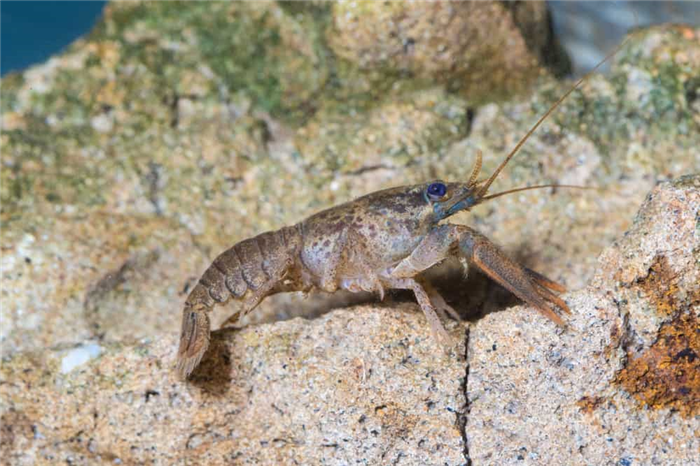
Crayfish, like most crustaceans, are omnivorous, and they will eat both plant and animal matter. They will consume almost everything they come across. Their diets consist mainly of dead decaying matter as it is the most accessible source of food.
They will latch on to any dead animal or plants swept downstream by fast currents. By the time it reaches the crayfish, the food material is easy to break apart and eat.
Some of the foods they eat in the wild include:
- Decomposing matter –such as dead animals, for example, a dead fish.
- Decaying vegetation –rotting plant matter can serve as treats for crays as they’re easily torn apart and eaten.
- Algae
- Worms –e.g., earthworms and bloodworms.
- Insects –like flies, mosquitoes, and dragonflies.
- Insect larvae.
- Amphibian tadpoles –such as frogs or salamanders, are hunted by crayfish.
- Shrimp
- Plankton
- Vegetation– for example, grass, weed, and tree leaves.
- In times where food is lacking, crayfish have cannibalistic tendencies and might one another.
It is difficult for crayfish to capture live fish in the wild. Fish are faster and better swimmers than crayfish and can easily escape them in open streams or lakes.
Because crayfish are not the best of swimmers, the food they eat must sink to the river floor before eating it. This limits their choice of foods to eat. However, lots of things end up in the lake and stream floors that crayfish will eat.
Crayfish are nocturnal and mainly carry out their feeding activities under cover of night. They will scavenge for whatever food is available to eat.
What Do Crayfish Eat As Pets?
Your crayfish’s tank environment needs to be similar to that of their environment in the wild. By doing so, you help your crayfish avoid anxiety.
As previously mentioned, crayfish will eat just about anything and therefore are easy to feed. Below are examples of foods you can provide your pet crayfish:
- Sinkable pellets –include algae, kelp, and shrimp pellets.
- Vegetables –like frozen peas, zucchini, carrot chunks, java moss, and broccoli stems.
- Algae wafers –are special biscuits fed to aquatic pets.
- Fruit –bananas, grapes, and apples are some fruits crays will eat.
- Live and dead fish.
- Aquarium plants –like guppy grass, densa, camboba, and hornwort are perfect for feeding crays as they last long. An added advantage is that they are affordable.
- Meat–crays will eat anything from poultry, fish, beef, lamb, you name it!
- Crays can eat mosquito and other insect larvae.
- Fish foods –can easily make up a balanced diet for crays. Feed to them in small amounts to prevent wastage.
- Krill –are small crustaceans that crays enjoy eating. They serve as a ready source of protein.
- Snails
Feeding your crayfish using tongs helps them get used to people and their new environment.
Live food like small fish makes feeding time more exciting as they have to hunt for their food actively. You can feed your leftover veggies from a meal to your crayfish to avoid wastage of food.
Leafy greens such as kales and spinach are easy for them to tear apart with their claws.
Crayfish will also help keep their tanks clean through their feeding habits. They will feed on algal or bacterial blooms that occur in the tank.
Algal and bacterial bloom refers to the rapid increase in the number of algae or bacteria in freshwater.
It is not uncommon for crayfish to spend a better part of their days in their hideouts. Establishing a regular feeding routine will encourage them to come out more to feed.
If you don’t feed your crayfish enough, they may become cannibalistic and attack one another if two or more crays occupy the same tank.
Tips To Feeding Crayfish
Crayfish make lovely pets. Very little is required to raise them. The most important thing is to raise them is a spacious tank/aquarium to roam freely. Feeding them is a simple task as they aren’t picky eaters.
To effectively care for and ensure that your crayfish stays healthy, here are some tips to consider:
Prepare a tank to house your crayfish.
- Ensure your tank has an air bubbler; crayfish may drown if submerged in water for long periods without a separate source of oxygen.
- Crayfish prosper in cool conditions and therefore don’t purchase a heated tank.
Fill the tank with freshwater.
- Setting your tank up indoors will help maintain constant temperatures for your crayfish. Consistent temperatures help them thrive, be healthy and active.
Regularly change the water in your tank.
- You should perform this practice at least once every week as crayfish generate large amounts of waste products.
- If your tank lacks a filter, changing the water twice a week would be more effective in maintaining a clean environment for your crayfish.
Provide your crayfish with shrimp pellets once a day.
- Pellet foods are rich in protein and other nutrients that help in the development of healthy shells.
- You can also feed them frozen aquarium foods like bloodworms, brine shrimp, and daphnia.
- Avoid feeding your crayfish live uncooked shrimp as they are carriers of diseases fatal to them.
Supplement your crays diet with veggies.
- Occasionally cut some cabbage, cucumber, or zucchini into small pieces and let them sink to the bottom of the tank.
- Crayfish will gladly eat spoiled or decaying matter, so don’t throw away those rotting bits of food!
Don’t overfeed your crayfish.
- Remove any uneaten portions of food from your crays tank to prevent it from decomposing and dirtying the tank water.
- When crayfish overeat, their exoskeletons become soft and weak.
Ensure your crayfish is safe from other fish that may occupy the tank.
- Though crayfish don’t pose a threat, fish like catfish are known to attack them. This, in turn, may lead to injury or death of one or both animals.
- Avoid keeping more than one crayfish in one tank. Different species of crayfish in the same tank are likely to attack and kill one another.
You should provide your crayfish with the best conditions for molting.
- Once every few months, your crayfish will shed its exoskeleton to accommodate its growing body.
- Don’t remove its exoskeleton from the tank once shed, as it will feed on it for nutrients required to grow a new one.
- Avoid feeding it for the first few days after it molts.
- To prevent your crayfish from succumbing to iodine deficiency after molting, add a few drops of potassium iodide into their water.
Lastly, keep your tank covered to prevent your crayfish from getting out. Crayfish are natural explorers by nature and won’t miss out on an opportunity to explore beyond their horizon.
Frequently Asked Questions (FAQs)
How long can a crayfish live above water?
Crayfish will survive outside water for several days only. They will have to find a freshwater water source to wet their gills. Otherwise, they might end up dying.
Do crayfish eat poop?
Despite crayfish tendencies to eat almost everything, they don’t benefit from feeding on poop belonging to them or other animals.
How long can a crayfish do without food?
Crayfish can go without food for about a week. In cases where you have to travel for short periods, ensure you feed them beforehand. Also, it’s essential to have recently cleaned your tank to prevent dirt build-up while you are away.
Summary
Knowing ‘what do crayfish eat?’ is vital when it comes to keeping them as pets. They make fantastic pets as they require minimum attention, making them easy to look after.
The fact that they eat practically anything you offer them is an added advantage.
What is the natural habitat of a crawfish?
The natural habitat of a crawfish is freshwater environments such as lakes, rivers, and streams. However, they can also be found in ponds and swamps.
Crawfish are small, lobster-like creatures that can be found in freshwater environments all over the world. They typically have red or brown bodies and are covered in hard shells. Crawfish can range in size from a few centimetres to several inches long. The diet of crawfish is diverse and depends on what is available to them in their environment.
In the wild, they typically eat small invertebrates, plants, and algae. However, they may also feed on fish and other larger aquatic creatures if they are available. In captivity, their diet may consist of pellets, flakes, or live food. Crawfish reproduce by laying eggs. The female crawfish will lay her eggs in a burrow, and the male will fertilize them.
You may also read:
Amazon and the Amazon logo are trademarks of Amazon.com, Inc, or its affiliates.
